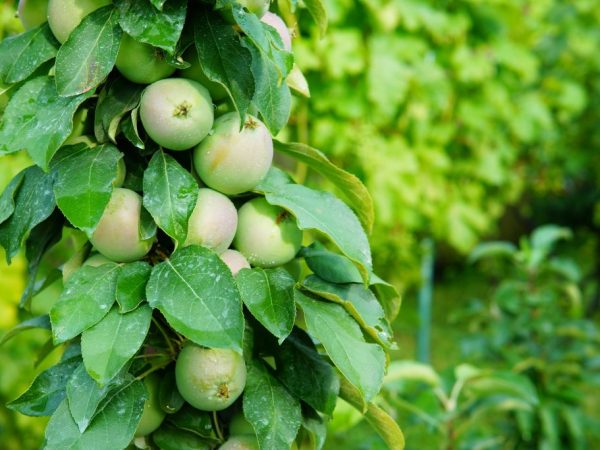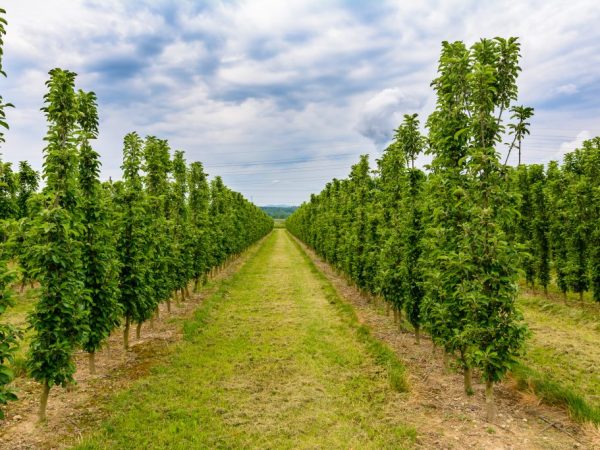Description of the columnar apple-tree Malukh
The apple tree columnar Malyukha is a compact tree with good productivity. Its first columnar ancestor appeared in Canada when an enthusiastic breeder noticed an apple tree bearing fruit from a stem branch. It was used for a new variety "leader", on the basis of which they began to be bred in different countries, including Russia.

Description of the columnar apple tree Malukha
Variety characteristic
The Malukha apple tree belongs to dwarf varieties and reaches 180 cm (sometimes 10-20 cm higher).
The neat column is decorated with a compact crown, and apples are evenly distributed along the slender trunk.
Ripe fruits are light green in color, sometimes they are covered with a slight blush. These are very aromatic sweet and sour apples of medium size (150-250 g), juicy and crunchy, with a thin skin and a weakly expressed waxy bloom.
The positive characteristics of the variety include frost resistance and good yield (for its size) - with proper care, up to 14 kg of apples can be harvested from one tree that has reached 5 years.
The first crop appears in the second year of life and averages 2-5 kg. The fruits ripen in September and are excellent keeping quality.
Dignity
The columnar tree has many advantages:
- Fruits that are evenly distributed along the trunk, it does not weigh it down and cannot break;
- Apples are very convenient to pick - there is only one branch, besides, the tree is not tall;
- It is easier to care for a compact tree than for a large and spreading one;
- The apple tree does not take up much space, but it gives a decent harvest;
- The first crop appears already in the second year after planting;
- It looks very decorative and perfectly complements the design of a small area;
- The fruits are firmly attached and do not fall off on their own;
- The apples are large enough, tasty and have good keeping quality;
- This fruit variety is frost and pest resistant.
disadvantages
The description of the Malyukha variety will be incomplete without indicating the shortcomings, but there are very few of them:
- With insufficient care, the fruits of the apple tree may shrink, and the yield may decrease;
- The variety is considered to be productive for its size, but not in comparison to larger trees;
- Productivity may decline after 6-7 years of fruiting;
- The cost of seedlings of this apple tree is quite high and they are not always available.
Landing

There should be one and a half meters between the rows of seedlings
It is better to prepare a planting hole in the fall, and plant a tree in the spring. The roots do not go deep into the ground, so the recommended depth of the hole is 50 cm.The width is determined depending on the shape of the roots of the seedling, usually its diameter is 50-60 cm.
The minimum distance between trees is 80 cm, and if planting is carried out in several rows, then 130-140 cm are left between them.
Sand and crushed stone (about 20-25 cm) are poured into the pit, the second layer is compost or humus, the third is hay, and the fourth is sawdust. A peg is dug into the formed mound - a support for the seedling.
For planting, take an annual tree. The roots of the seedling are straightened, and then placed in a hole and tied to a support.The hole is covered with earth, abundantly watered and mulched.
Care
Young seedlings require moist soil, so in dry weather they should be watered at least twice a week. You can feed the plant with nitroammophos (50 grams per tree is enough), and a month later - with a solution of carbamide.
You need to apply top dressing in a well-watered soil. Regular weeding and loosening of the soil is necessary for the tree so that the weeds do not pull off nutrients. Mulching can be done along with weeding and loosening to reduce future weeds.
Pruning is done not only in order to form the crown, but also to extend the fruiting period. In the second year, you need to remove the lateral branches to the second buds, in the third - cut off all young shoots, in the fourth - remove the branches that bore fruit in the third year, and new ones - to the second buds.
The apple tree is considered resistant to pests, but prevention measures are still needed. These include: protection from ants, spraying with fungicide, wrapping the trunk for the winter from rodents.
Gardeners reviews
According to the description, the columnar variety of the Malukha apple tree is an excellent option for a small garden plot. Its main advantages include winter hardiness, compactness, good yield and decorative appearance.
Gardeners say that apples are very tasty. They appear in the second year, but in terms of yield, the experience is different: for some, the first harvest was several pieces, while for others, several kilograms.
The keeping quality of fruits also raises different opinions: according to some reviews, the fruits do not lose their properties until January, but according to others, apples become soft in December.
Many people note the winter hardiness of the tree, but they prefer to play it safe - plant an apple tree in a sunny place and insulate the pit. It is also recommended to choose a place protected from the winds for planting.

